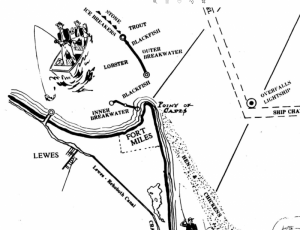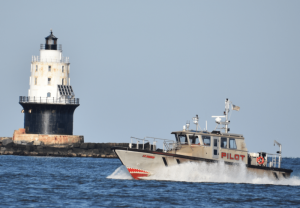Finally, some new fish to catch and talk about
Summer fishing rarely changes, just the frequency of catches. Some weeks it is pointless to do fishing reports, since nothing changes. What does change are the water temperatures. Now we are in the bathtub months.
Flounder become more frequent along the surf. Spot, croaker and the usual small fish still abide. Kingfish have been scarcer recently; you have to go a little farther out (cast) and deeper on the higher tides. Fishing the surf at a dead low tide in the middle of the day is pointless. The surf is 80 degrees. Even the pompano have slowed down.
Now we finally have puppy drum in the surf, juvenile black drum that many mistake for sheepshead. Same baits and DS Custom Tackle top and bottom or spot rigs we use for the other small fish. Fishbites has been the easiest to use; bloodworm availability is random. Sand fleas can be dug up or use the Fishbites sand flea formula. Puppy drum can still be caught in the surf and waterways as late as November. The puppies showing up marks another incoming visitor I love to catch in the surf – albies are inbound.
North Jersey to central Jersey and lower have come hot for albies in the surf. They are a blast to catch on spoons and other metals. Cast and reel very fast, like wrist-crushing fast, they blitz bait. Deadly dicks are perfect for that action, spoons will surface too fast. It is like hooking an angry torpedo.
Finding albies is easy; just wait for them to come by in schools. The water will boil a little like bluefish, but it is different-looking and easy to spot. The birds help too; they will follow albies more than the bluefish schools. The albies will also porpoise while chasing bait, which is a really good indicator. Based on reports up north I’d expect to see them in a week or so in Delaware waters. The Delaware bay boat anglers will catch them sooner than the surf anglers. If you are out on a weekday and the beach is empty, grab a rod for casting and be ready to move the vehicle in the direction of the fish. By the time you read this, I expect to see several boats flounder fishing offshore catching albies. Get a rod set up much like you would for catching striped bass.
The water temperatures are on fire right now. Bathtub conditions which are perfect for more vibrio blooms. The Inland Bays recreational water advisory says be careful wading in hotter-than-usual water, and bathe or wash off afterward. Wear old shoes when walking in the Inland Bays to prevent cuts from glass and shells.
Massey’s Ditch water temperatures are 81-84 degrees. Fish early mornings and late evenings for better luck at catching. The drive-on drinking beaches will be just that on the weekends.
This is why we like that the Point opened; much better water to fish. Deeper, cooler, fast-moving water. We do have schools of fish, bunker mostly, all over the place. You can check live Delaware Bay water conditions on the Delaware Bay Operational Forecast System. Just click on any of the red pins and it will pull up a page of all kinds of live data – wind, tide, salinity and water temperatures.
The Point is open! We waited all summer for this day with gleeful anticipation. It is one of our favorite places to fish. Pro tip – for some reason, almost every year the fishing is horrible the first week or so. We don’t care and go out anyway, because you never know and we want to see our favorite place.
The Point is often confused with Herring Point, which is on the opposite or Rehoboth Beach side of Cape Henlopen State Park. Back in the day, the Point was known as the Point of Capes before Fort Miles was established and then Cape Henlopen State Park renamed it the Point.
It changes shape every year. Sand moves north along Delaware’s beaches and is deposited at the Point and the flats. The way the Point is growing creates issues for the outer wall and the Harbor of Refuge Lighthouse (we call it the spark plug). The structure is in danger of toppling into the ocean, because the scouring is digging out more sand between the Point and the lighthouse.
Fishing the Point has many options, oceanside back to the bayside flats, and in between. There are a few rips that start at the bayside point and push water to the churning rips of the Point on the outgoing tide. The bayside point is where the bay flats area meets the edge of the point (shoal). Swimming in this area is discouraged. Many a time we tell passing kayakers and SUP users to not go beyond this area. Some listen; others have a colorful reaction. So we dial 911 and wait to hit send. That is a great way to get shot out into the Atlantic ocean.
The Point itself is like a large washing machine; it is deceptive. The sand in the water reminds you of a sand bar in low water, but it’s really the edge of a giant shoal. Almost a hundred feet deep at the bottom toward the lighthouse. Fishing there is different, casting into the rips and churning water looking for bluefish, striped bass and weakfish. We drift the Point on weekdays, casting 8- to 10-ounce-plus weights on a line with a fly and spoon. Letting it drift in the current around the corner, hoping to get hammered by a big fish. You have to walk along the Point, follow the current, and hold your surf rod straight up. When you complete the drift, reel in, walk back, and repeat. Holding bottom there is not possible, but many try. Sometimes you can hold along the edge and catch fish; it depends on how the Point is shaped up each year.
The space between the bayside point and the actual Point is shallow on the edge then deep, much like a shoal or giant sand bar. Usually the bluefish schools will move along the shallow areas. You do not need to step into the water to cast, since at that point you are standing in the fish, which are within 10 feet of the shoreline most times. We watch schools of bluefish move right down this shoreline all the time.
Flounder will sit in these areas hitting mullet as the schools swim by as well. This is a good place to cast net for mullet, then use them for bait in the same spot, just a little farther out. When you cast out farther your weight will stick in the moving sand or get jammed up on the edge of what some think is an old wall. I have some scuba diver friends in town for a while, and we might be sending them down to check this out this year.
The sights and sounds of the Point are like no other Delaware beach. Pelicans diving on fish, horseback riders, planes, charter and head boats heading out to fish. The ferry motoring by loaded with cars and passengers headed to and from Cape May. Pilot boats ripping through the heavy currents taking their Delaware River pilots to the big ships offshore. SUPs and kayakers getting jammed up in the rough water hoping we don’t have to rescue them. Gorgeous sailboats running the Delaware Bay to Cape May or just out for the day. You never know what you will see at the Point, and beachcombing is amazing too. Overnight surf fishing trips are a blast there; the sunsets are dope!
We will be sure to give you a tour of all the Point’s new features on the Delaware Surf Fishing website. We are also doing a beach cleanup there Tuesday, Sept. 7, since we had to postpone the Sept. 2 event due to weather. We will host weekly beach cleanups every Tuesday until the season slows down, then move to Saturdays or Sundays.




























































